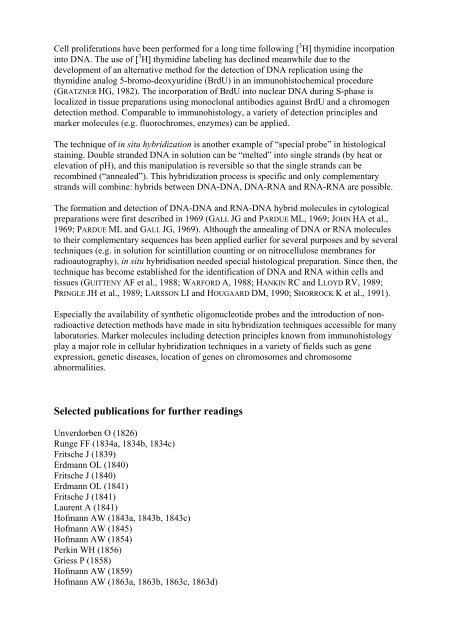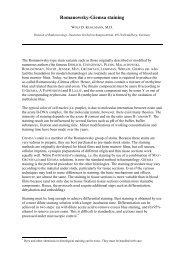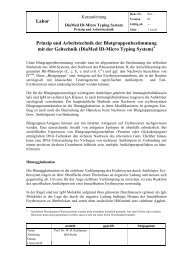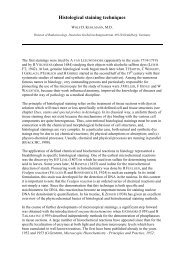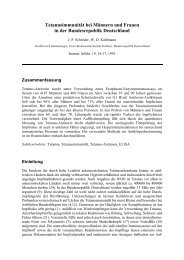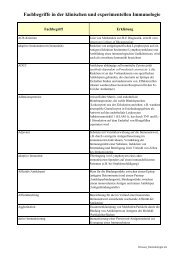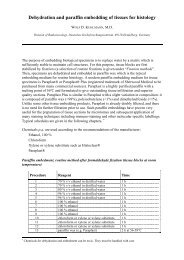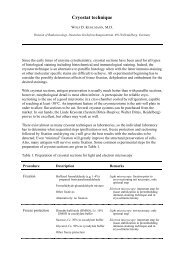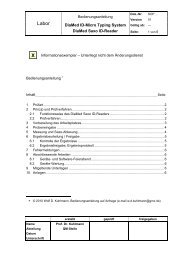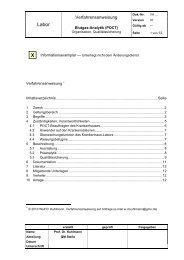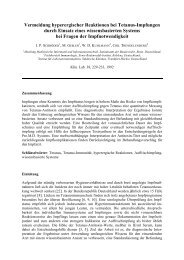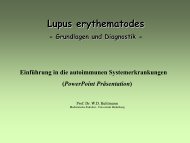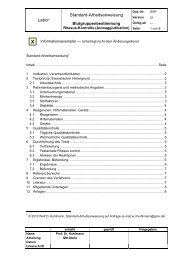Dyes, stains, and special probes in histology
Dyes, stains, and special probes in histology
Dyes, stains, and special probes in histology
Create successful ePaper yourself
Turn your PDF publications into a flip-book with our unique Google optimized e-Paper software.
Cell proliferations have been performed for a long time follow<strong>in</strong>g [ 3 H] thymid<strong>in</strong>e <strong>in</strong>corpation<strong>in</strong>to DNA. The use of [ 3 H] thymid<strong>in</strong>e label<strong>in</strong>g has decl<strong>in</strong>ed meanwhile due to thedevelopment of an alternative method for the detection of DNA replication us<strong>in</strong>g thethymid<strong>in</strong>e analog 5-bromo-deoxyurid<strong>in</strong>e (BrdU) <strong>in</strong> an immunohistochemical procedure(GRATZNER HG, 1982). The <strong>in</strong>corporation of BrdU <strong>in</strong>to nuclear DNA dur<strong>in</strong>g S-phase islocalized <strong>in</strong> tissue preparations us<strong>in</strong>g monoclonal antibodies aga<strong>in</strong>st BrdU <strong>and</strong> a chromogendetection method. Comparable to immuno<strong>histology</strong>, a variety of detection pr<strong>in</strong>ciples <strong>and</strong>marker molecules (e.g. fluorochromes, enzymes) can be applied.The technique of <strong>in</strong> situ hybridization is another example of “<strong>special</strong> probe” <strong>in</strong> histologicalsta<strong>in</strong><strong>in</strong>g. Double str<strong>and</strong>ed DNA <strong>in</strong> solution can be “melted” <strong>in</strong>to s<strong>in</strong>gle str<strong>and</strong>s (by heat orelevation of pH), <strong>and</strong> this manipulation is reversible so that the s<strong>in</strong>gle str<strong>and</strong>s can berecomb<strong>in</strong>ed (“annealed”). This hybridization process is specific <strong>and</strong> only complementarystr<strong>and</strong>s will comb<strong>in</strong>e: hybrids between DNA-DNA, DNA-RNA <strong>and</strong> RNA-RNA are possible.The formation <strong>and</strong> detection of DNA-DNA <strong>and</strong> RNA-DNA hybrid molecules <strong>in</strong> cytologicalpreparations were first described <strong>in</strong> 1969 (GALL JG <strong>and</strong> PARDUE ML, 1969; JOHN HA et al.,1969; PARDUE ML <strong>and</strong> GALL JG, 1969). Although the anneal<strong>in</strong>g of DNA or RNA moleculesto their complementary sequences has been applied earlier for several purposes <strong>and</strong> by severaltechniques (e.g. <strong>in</strong> solution for sc<strong>in</strong>tillation count<strong>in</strong>g or on nitrocellulose membranes forradioautography), <strong>in</strong> situ hybridisation needed <strong>special</strong> histological preparation. S<strong>in</strong>ce then, thetechnique has become established for the identification of DNA <strong>and</strong> RNA with<strong>in</strong> cells <strong>and</strong>tissues (GUITTENY AF et al., 1988; WARFORD A, 1988; HANKIN RC <strong>and</strong> LLOYD RV, 1989;PRINGLE JH et al., 1989; LARSSON LI <strong>and</strong> HOUGAARD DM, 1990; SHORROCK K et al., 1991).E<strong>special</strong>ly the availability of synthetic oligonucleotide <strong>probes</strong> <strong>and</strong> the <strong>in</strong>troduction of nonradioactivedetection methods have made <strong>in</strong> situ hybridization techniques accessible for manylaboratories. Marker molecules <strong>in</strong>clud<strong>in</strong>g detection pr<strong>in</strong>ciples known from immuno<strong>histology</strong>play a major role <strong>in</strong> cellular hybridization techniques <strong>in</strong> a variety of fields such as geneexpression, genetic diseases, location of genes on chromosomes <strong>and</strong> chromosomeabnormalities.Selected publications for further read<strong>in</strong>gsUnverdorben O (1826)Runge FF (1834a, 1834b, 1834c)Fritsche J (1839)Erdmann OL (1840)Fritsche J (1840)Erdmann OL (1841)Fritsche J (1841)Laurent A (1841)Hofmann AW (1843a, 1843b, 1843c)Hofmann AW (1845)Hofmann AW (1854)Perk<strong>in</strong> WH (1856)Griess P (1858)Hofmann AW (1859)Hofmann AW (1863a, 1863b, 1863c, 1863d)


